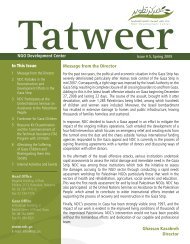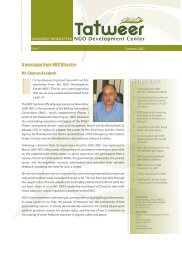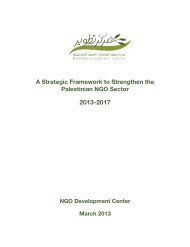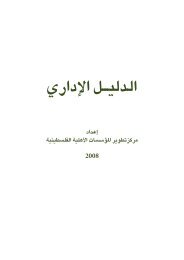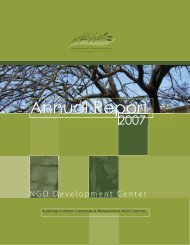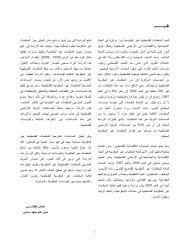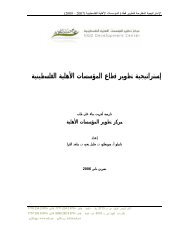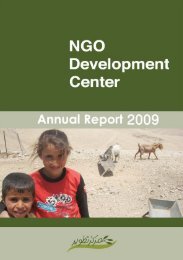Tracking External Donor Funding.pdf - NDC
Tracking External Donor Funding.pdf - NDC
Tracking External Donor Funding.pdf - NDC
Create successful ePaper yourself
Turn your PDF publications into a flip-book with our unique Google optimized e-Paper software.
The following Figure 28 compares the distribution of<br />
PNGOs with that of the Palestinian population as a<br />
whole. Though at a glance it appears that the distribution<br />
of PNGOs aligns with the distribution of the population,<br />
there are slight differences. While rural areas are almost<br />
exactly aligned, the number of PNGOs operating in<br />
urban areas is higher than the percentage of Palestinians<br />
living there, with the opposite being true of refugees.<br />
3.7.2 <strong>External</strong> Aid to PNGOs versus Palestinian<br />
Demographics<br />
The following Figure 29 compares our survey results<br />
with the Palestinian Population distribution, the<br />
distribution of PNGOs and the distribution of those<br />
under the poverty line by target population. We also<br />
looked into the differences in funding to target<br />
populations between governmental and nongovernmental<br />
sources.<br />
Urban – While the percentage of Palestinians living in<br />
urban areas in 2007 was 53.1%, over half of them<br />
(50.6%) are under the poverty line. In spite of this, Urban<br />
Palestinians only received 38% of the total externally<br />
funded PNGO projects, with a marked difference<br />
between Governmental (49%) and INGO donors (32%).<br />
Rural – The percentage of Palestinians living in rural<br />
areas in 2007 was approximately 31%, 29.8% of them<br />
live below the poverty line. In spite of these two facts,<br />
rural Palestinians receive 41% of total externally funded<br />
projects managed through PNGOs, with only a slight<br />
difference between Governmental (34.8%) and INGO<br />
donors (44.5%).<br />
Figure 29: <strong>External</strong> <strong>Donor</strong> <strong>Funding</strong> to Target Population (2008)<br />
100%<br />
90%<br />
80%<br />
70%<br />
60%<br />
50%<br />
40%<br />
30%<br />
20%<br />
10%<br />
0%<br />
Palestinian Population<br />
(2007)<br />
Distribution of Poor<br />
(2004)<br />
PNGO HQ Location<br />
(2006)<br />
<strong>External</strong> Aid<br />
Distribution to PNGOs<br />
(2008)<br />
Urban Rural Refugee<br />
Sources: Palestinian Population statistics are taken from PCBS (2007).<br />
Palestinian Poverty Distribution was calculated on the basis of consumption from<br />
PCBS (2004).<br />
<strong>External</strong> aid Distribution – MAS, 2009 – <strong>Donor</strong> Survey<br />
Refugee – While comprising 15.9% of the total<br />
population in the WB&GS, 19.6% of them live below<br />
the poverty line. 21% of all external aid channeled<br />
through PNGOs targets the refugees, with a marked<br />
difference between Governmental 41 (16%) and INGO<br />
donors (23.8%).<br />
3.7.3 <strong>Tracking</strong> <strong>External</strong> <strong>Funding</strong> to PNGOs by<br />
Target Area (1999 -2008)<br />
The following section focuses on the distribution of<br />
external aid to PNGO projects according to the target<br />
area of the project’s implementation over ten years.<br />
According to our survey results, external aid to PNGO<br />
projects targeting urban populations rose from 2000 to<br />
2003, before remaining steady just below 40% of the<br />
total, 13% lower than the Palestinian percentage of urban<br />
inhabitants.<br />
<strong>External</strong> aid to PNGO projects targeting rural<br />
populations is consistently the highest, garnering 42.2%<br />
of aid in 2000 and 2007, while only comprising 31% of<br />
the total population in 2007. This is in large part due to<br />
the scale of projects targeting urban areas versus rural,<br />
the latter receiving more large-scale assistance in terms<br />
of infrastructure.<br />
41<br />
While Governmental donors channel a smaller percentage of their aid through PNGOs to the refugee population than INGO donors, the former<br />
invest heavily in this sector through support to UNRWA.<br />
45


